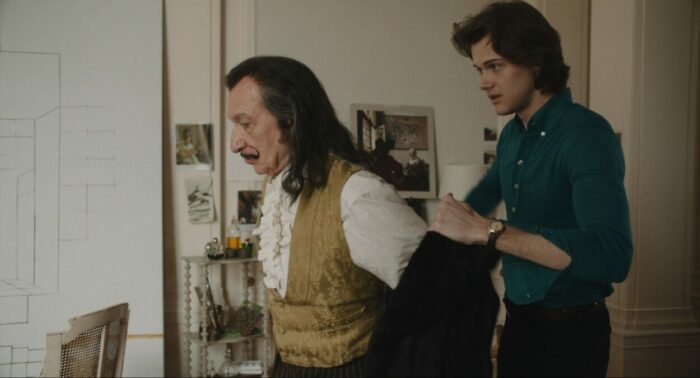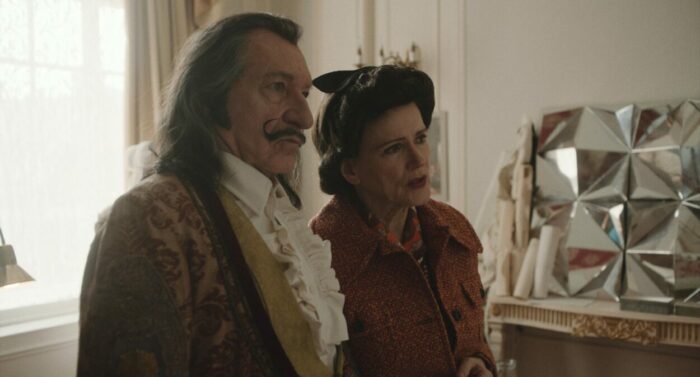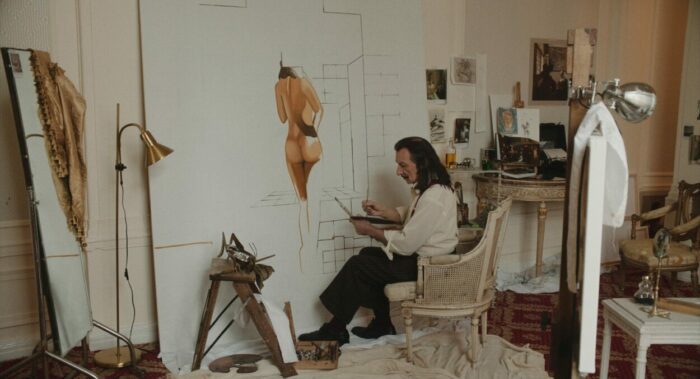Instantly recognizable by his iconic mustache, Salvador Dalí was a surrealist painter and one of the most famous living artists of the 20th century, one whose work was filled with wonder and wackiness. The twisted dreamlike worlds he created in his paintings have captivated audiences for a century. All of this would seemingly make him the perfect subject for a biopic. On paper, Mary Harron’s latest feature Dalíland is a great idea, but the film doesn’t dare match the energy of Dalí’s work.
An innovative filmmaker like Harron, whose past features include I Shot Andy Warhol (1996) and American Psycho (2000), seems more than capable of creating something unique and exciting that could capture Dalí’s zaniness. She could have taken the cinematic art form in so many different directions to visually express his sentimentality and creative style. But perhaps that is simply not the direction she wanted to take the story, so instead what we get is a painfully average biopic.

Our entry point into the story of the famed painter is a young man who catches a telecast of Dalí on the game show What’s My Line prefacing the news that Dalí was badly burned in a house fire. We jump back several years earlier to learn that this young man is an art school dropout named James played by Christopher Briney, whose only other major acting credit is in the series The Summer I Turned Pretty. All James wants is to be near the art scene. His job at the Dufresne Gallery has him running several odd-job errands, one of which is to deliver some cash to Gala (Barbara Sukowa), wife of the enigmatic Dalí. On this errand, James is quickly whisked away into one of the artist’s many lavish parties. Across the room, he spots Dalí (Sir Ben Kingsley) in conversation with a young Alice Cooper (an interesting pair, I know, but they were actually friends and even collaborators), and finds himself in awe of the artist’s presence. From there James is invited to a more exclusive dinner party with Dalí: why he of all people was invited I’m not sure, but the invitation allows the plot to progress and James to form a bond with the painter.
Dalí sees something in James. What that is remains unclear as Briney’s performance gives no indication of uniqueness or originality, but Dalí sees something anyway. He describes the boy as angelic and begins to affectionately call him San Sebastian, quickly taking him on as a personal assistant. Due to their new proximity, we get to see Dalí’s life unfold through James’s perspective. This would be a fairly compelling angle to take the story if James were in any way an interesting character. All we know about him is that he likes art, which is a start, but without any developed backstory or an understanding of his aspirations, he’s left being a poor window into Dalí’s existence. This could maybe be forgiven if Briney and Kingsley had great chemistry, but the pair are stiff around each other, making it difficult to believe the tortured artist and his protégée storyline.

In the scenes without James, Sir Ben Kingsley’s Dalí shine sa bit more. This isn’t his first time playing an artistic visionary as Kingsley played the filmmaker Georges Méliès in Martin Scorsese’s 2011 film Hugo. As he did in Hugo, Kingsley has a soft feeling of wonder in his performance that shows the passion these visionaries had. But in this film, the tenderness is equally matched with crazy outbursts. He refers to himself as next to a god and drops random quotes of supposed wisdom in one moment, and in the next, he laying in fetal position on the floor cradling a small cut on his finger in fear he will need to cut off his hand. It’s moments like these that leave us to wonder if Dalí was actually a genius or simply a madman.
At times, Dalíland makes attempts to break outside of the conventions of your typical biopic. We meet Dalí at the beginning of the film as an old man. Instead of his whole life being played from start to end the film primarily focuses on the later part of his life and the decline of his career. We only get sprinklings of his younger years through three brief flashback scenes, which fail to paint the picture (excuse my pun) of his formative years. If the flashback is going to be used as a storytelling device it needs to be used more often or more intentionally. Part of the reason these scenes don’t land is likely due to some pretty atrocious acting from Ezra Miller who played Dalí’s younger self. My theory is that another version of Dalíland exists with more of these flashback scenes, but the majority of them were cut when Miller’s controversies arose. Despite only appearing on screen maybe three times, Miller carries a higher billing than Briney.

Perhaps if the flashback device was utilized better, or successfully achieved with a different actor Dalíland could have narratively flowed more seamlessly. Instead, it relies a bit too heavily on your standard biopic formula. This is not to say that that formula doesn’t work, I tend to love movies about real people. Getting a peak behind the curtain into a sensationalized version of a celebrity’s life is inherently interesting. We’re fascinated by famous people, its a voyeuristic tendency we can’t seem to get enough of. I want to know about Salvador Dalí and how this bizarre artist lived, but the tropes of the genre cannot be avoided therefore there isn’t much we haven’t already seen. We see Dalí at the peak of his fame and how he deals with his decline, his mix-ups with sex and drugs are a throughline, and you see the quintessential moment when he does the thing everyone knows him for, in this case, it’s him painting The Persistence of Memory, which we never actually see.
My biggest gripe with Dalíland is not the muddled acting, not the clichéd script, not even the Ezra Miller jump scare, but the fact that not once during the entire one-hour-and-thirty-seven minute run time do we see any of Salvador Dalí’s art. If you’re not going to translate his style into the filmmaking in any way we at least need to see his paintings. Now I understand that this was likely a legal issue and they weren’t able to secure the rights to show his work on screen, but it is difficult to understand a surrealist artist like Dalí whose ideas were so unique and abstract without physically seeing these ideas in their realized form.
Salvador Dalí has grown into a larger-than-life figure to the point of caricature whose unconventional artistic ideas have enthralled audiences for nearly a century. Harron’s attempt to capture the life of one of the great surrealist painters fails to frame his grandiose career into anything more than the now-clichéd tropes of the biopic genre.





I am Cesare, From Milan, Italy , Saw movie last night , Totally agree with your review….
Specially the lack of showing any Dali’s art. , Including the moment . “melting cheese- – watch” , that inspired his famous Persistence ot the Memory ,,,( that we don’ see. on the screen….)
I guess probably because of some copyrights issue , but during the entire movie time do we see any of Salvador Dalí’s art., That ‘s simply ridiculous , as well as the shaved eyebrows of Christopher Briney and the totally miscasted actrice who plays Amanda Lear….. Bravo to Kingsley and Sukowa, but that s another story….. Ciao